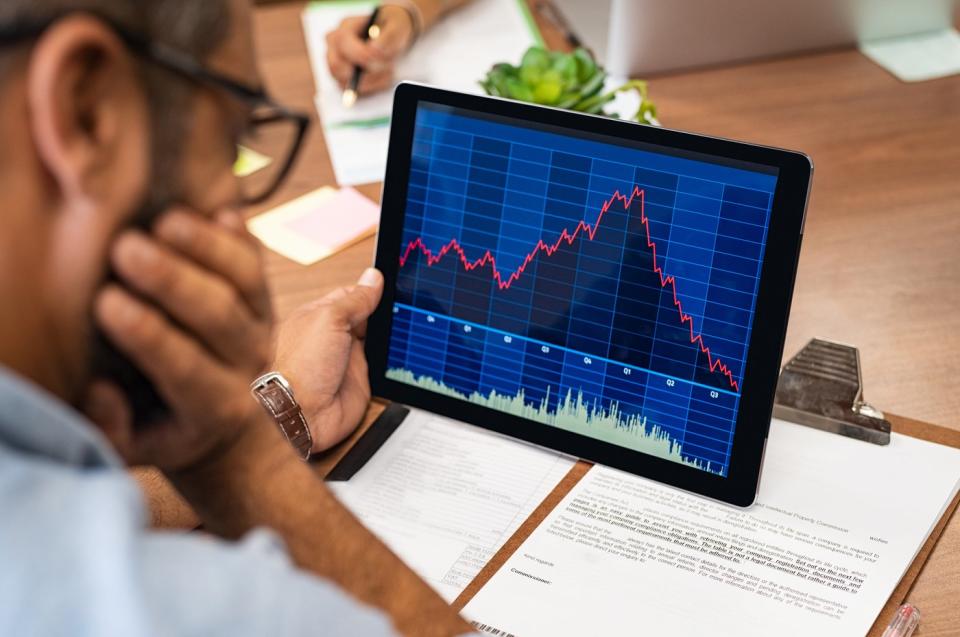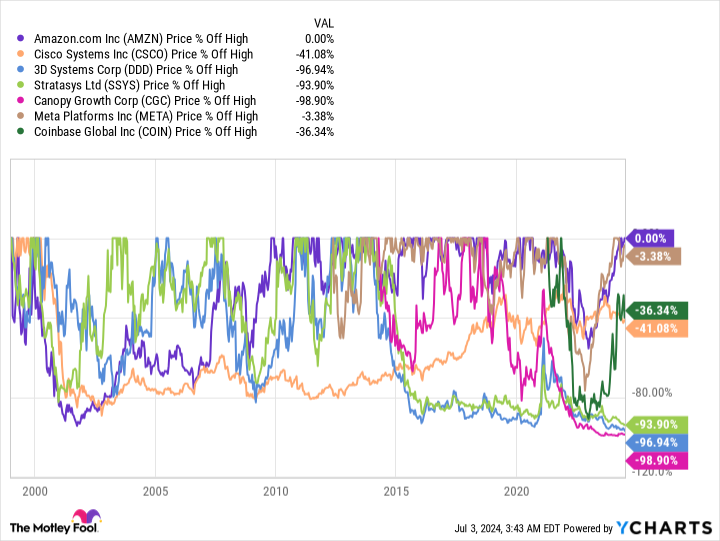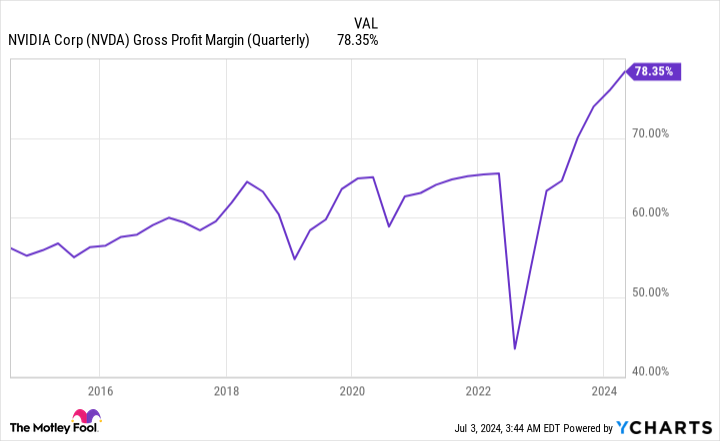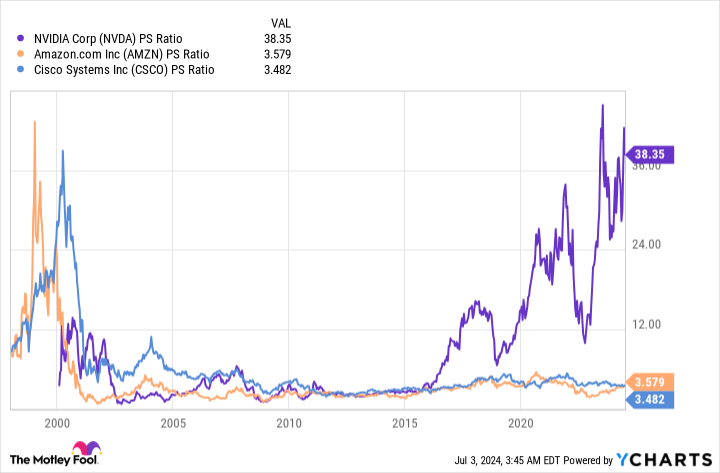This has been a year full of milestones. Since mid-May, the iconic Dow Jones Industrial Average has made its first close above 40,000, the broadly supported S&P 500 climbed above the 5,500 level, and the growth-driven Nasdaq Composite crossed the 18,000 mark. This full-fledged bull market is thanks to the euphoria surrounding the rise of artificial intelligence (AI).
Without getting too complex, AI uses software and systems to perform tasks that are normally overseen by humans. What makes AI so special is the ability of software and systems to learn and evolve without human supervision. If AI software and systems could become more proficient at their tasks over time, or perhaps learn new skills, virtually every sector and industry in the global economy would benefit.
While dozens of companies have benefited from investors pouring their capital into the AI revolution, no company stands out more than semiconductor giant Nvidia (NASDAQ: NVDA).

Nvidia has experienced a historic operational rebound
Nvidia’s calling card to success is its AI-driven graphics processing units (GPUs). The company’s H100 GPU in particular has quickly become the go-to chip for making split-second decisions in high-compute data centers.
According to semiconductor analysts TechInsights, Nvidia was responsible for shipping 3.76 million of a possible 3.85 million AI GPUs in 2023. Enterprises are lining up to buy the H100 to train large language models and run generative AI solutions.
One of the key advantages for Nvidia is that enterprise demand for AI GPUs has far outstripped supply. Based on the law of supply and demand, the price of a good or service is likely to increase if the supply of that good or service cannot meet demand. Nvidia has been able to quickly increase the price of its GPUs, which in turn has driven adjusted gross margins to over 78% during the fiscal first quarter (ended April 28).
Despite its first-mover advantages, the market-leading company isn’t resting on its laurels. It’s expected to roll out its next-generation AI GPU architecture, known as Blackwell, in the second half of 2024. This new platform could accelerate quantum computing, data processing, engineering simulations, generative AI solutions, and more.
In addition to Blackwell, CEO Jensen Huang gave the world a sneak peek at its next-gen Rubin platform in June. Rubin will feature an all-new central processing unit (known as Vera) and is expected to debut in 2026. In other words, Nvidia appears to have a path to sustained compute advantages over its peers.
While Nvidia has been beating Wall Street’s highest revenue and profit expectations for more than a year and its operational growth has been on target, evidence is mounting that the company may be in a bubble.
While history doesn’t exactly repeat itself on Wall Street, it does tend to rhyme. Based on three compelling charts, we may have already seen a top for Wall Street’s hottest AI stock.
Innovations that represent the next big breakthrough always survive an early bubble
Over the past 30 years, Wall Street and investors have had no shortage of next-big-thing investment trends to chase. The advent of the internet, genome decoding, business-to-business trading, Chinese stocks, nanotechnology, 3D printing, blockchain/cryptocurrency, cannabis, and the metaverse have captured the attention of new and seasoned investors alike.
But these trends do have one thing in common: they emerge at an early stage.
While it’s impossible to predict when the music will stop, the industry’s leading companies for all of the above trends eventually went under.


As you can see in the chart above, some of the most talked about investments of the past 25 years have nosedived after the bubble burst for their respective innovation, technology or trend. In no particular order:
-
The revolution in networking and e-commerce saw Amazon And Cisco systems During the dotcom bubble they lost about 90% of their value.
-
3D systems And Stratasysthat led the hype around 3D printing have never managed to match the increases of the early 2010s and are currently 97% and 94% below their respective record highs.
-
Canadian cannabis supply Canopy growth has fallen by as much as 99% since reaching its record high.
-
Play Cryptocurrency Coinbase Worldwide fell nearly 90% from its high close before recovering.
-
Social media expert Meta platformswhich was the face of the metaverse, dropped by about 80% before reaching new heights again.
The point I’m trying to make is that investors have overestimated the uptake of every new technology or trend over the past 30 years, and there’s no reason to believe AI will be any different. History (i.e. the chart above) strongly suggests that high growth expectations for AI will not be met, and that a period of maturation will be needed for this potentially disruptive technology.
Nvidia’s adjusted gross margin will not be sustainable
A second reason to suspect that Wall Street’s AI leader is in a bubble can be seen in the company’s current and expected adjusted gross margin.
As I noted earlier, Nvidia has undeniably benefited from AI GPU demand outpacing supply. The ability to raise prices has driven adjusted gross margin up 13.72 percentage points compared to the previous five quarters.


But as you can see in the chart above, an adjusted gross margin of around 60%, plus or minus a few percentage points in either direction, has been the norm over the past 10 years. While that’s not to deny that Nvidia has steadily improved its adjusted gross margin over time, it does suggest that a 13.72 percentage point increase in 15 months is not sustainable.
For example, Nvidia forecast an adjusted gross margin of 75.5% (+/- 50 basis points) for the second fiscal quarter. While this is still well above the historical average, a sequential decline of 235 to 335 basis points for the current quarter suggests that margin pressure is starting to take shape.
In the second half of 2024, Intel will roll out its Gaudi 3 AI accelerator chip on a large scale, and Advanced micro devices will ramp up production of its MI300X AI GPU. Furthermore, Nvidia’s four largest customers are all developing AI GPUs in-house for their respective data centers.
Even if Nvidia’s AI GPUs easily maintain their compute advantages, overwhelming enterprise demand for GPUs could allow these competitors to flourish and/or reduce data center real estate for Nvidia’s chips. In short, Nvidia’s fiscal second quarter margin guidance seems like a warning that its adjusted gross margin has peaked.
We’ve seen this before, and it wasn’t a pretty sight
The third chart that discredits Nvidia has to do with the company’s valuation.
To be fair, some traditional fundamental metrics suggest that Nvidia could still be a bargain for long-term investors. For example, Nvidia’s stock closed the July 2 session at nearly 34 times next-year earnings. While that’s a higher year-over-year earnings than the benchmark S&P 500, it’s not unreasonable when you consider that Wall Street is forecasting 46% annual earnings growth for the company through 2028.
There is, however, another valuation metric that is undeniably worrying.


As you can see in the chart above, Nvidia is valued at over 38 times its trailing-12-month (TTM) price-to-sales (P/S) multiple. For a leading company on Wall Street, this is one of the highest valuations we’ve ever seen. In fact, Nvidia’s valuation of 42 times TTM P/S in mid-June effectively matched the pre-dotcom bubble peaks of Amazon and Cisco Systems.
History has consistently shown us that extended valuations can be driven by short-term euphoria. But when viewed over a longer timeline, market leaders with nosebleed P/S ratios eventually get clobbered. While there is no concrete way to know in advance when a top has been reached, we have seen this scenario play out before, and the end result was not pretty.
While Nvidia has the resources to remain a successful company in the long term, these historical charts strongly suggest that the AI market leader is in a bubble.
Should You Invest $1,000 in Nvidia Now?
Before you buy Nvidia stock, here are some things to consider:
The Motley Fool Stock Advisor team of analysts has just identified what they think is the 10 best stocks for investors to buy now… and Nvidia wasn’t one of them. The 10 stocks that made the cut could deliver monster returns in the years to come.
Think about when Nvidia made this list on April 15, 2005… if you had $1,000 invested at the time of our recommendation, you would have $786,046!*
Stock Advisor offers investors an easy-to-follow blueprint for success, including portfolio building guidance, regular analyst updates, and two new stock picks each month. The Stock Advisor has service more than quadrupled the return of the S&P 500 since 2002*.
View the 10 stocks »
*Stock Advisor returns as of July 2, 2024
Randi Zuckerberg, former chief market development officer and spokeswoman for Facebook and sister of Meta Platforms CEO Mark Zuckerberg, is a member of The Motley Fool’s board of directors. John Mackey, former CEO of Whole Foods Market, an Amazon subsidiary, is a member of The Motley Fool’s board of directors. Sean Williams has positions in Amazon, Intel and Meta Platforms. The Motley Fool has positions in and recommends Advanced Micro Devices, Amazon, Cisco Systems, Coinbase Global, Meta Platforms and Nvidia. The Motley Fool recommends 3d Systems and Intel and recommends the following options: long Jan 2025 $45 calls on Intel and short Aug 2024 $35 calls on Intel. The Motley Fool has a disclosure policy.
3 Charts That Strongly Suggest Artificial Intelligence (AI) Giant Nvidia Is In A Bubble was originally published by The Motley Fool







